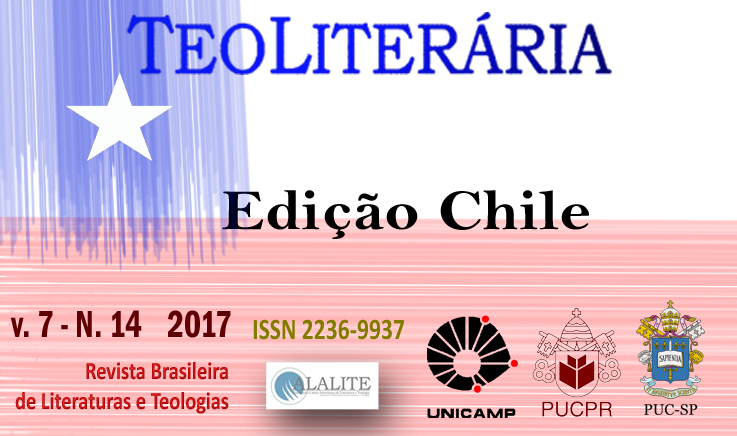T.S. Eliot and the tradition of Christian mysticism: the spatial paradox in Burnt Norton
DOI:
https://doi.org/10.19143/2236-9937.2017v7n14p55-69Keywords:
T.S. Eliot, Burnt Norton, Paradox, Christian Mysticism, Pseudo-DionysiusAbstract
The present article seeks to identify T.S. Eliot’s affinity to the tradition of Christian mysticism by analyzing the spatial paradox in the poem Burnt Norton, the first of the Four Quartets. Parting from a general reflection on the importance of the paradox with regard to God’s ineffability, the poem is analyzed from a spatial perspective. It becomes obvious that the spatial paradox is not only used as an argumentative pattern, but also as a compositional key element that structures the whole text, generating a particular down-up-down dynamic. The most curios aspect, in this context, is that the poem continuously formulates and subsequently denies its own spatial movement, thus, in the end, also denying itself.References
Anonymous. The Cloud of Unknowing. Ed. Patrick J. Gallacher. Kalamazoo, Michigan: Medieval Institute Publications, 1997.
Augustine. Confessions. Translated by John K. Ryan. New York: Image Books, 1960.
Beierwaltes, Werner. Proklos. Grundzüge seiner Metaphysik. Frankfurt am Main: Klostermann, 1979.
Biblia Vulgata. Ed. Colunga, Alberto, and Laurentio Turrado. Madrid: Biblioteca de Autores Cristianos, 2015.
Carballo, Pablo Zambrano. La mística de la noche oscura: San Juan de la Cruz y T.S. Eliot. Huelva: Universidad de Huelva, 1996.
Cooper, John Xiros. The Cambridge Introduction to T.S. Eliot. Cambridge: Cambridge University Press, 2006.
Eliot, T.S. The Complete Poems and Plays. New York: Harcourt, Brace and Company, 1952.
Eliot, T.S. “Tradition and the Individual Talent”. The Sacred Wood. Essays on Poetry and Criticism. New York: Alfred A. Knopf, 1921: 42-53.
Gardner, Helen. The Composition of Four Quartets. London: Faber and Faber, 1978.
Gordon, Lyndall. T.S. Eliot: An Imperfect Life. New York: Norton, 1998.
Haas, Alios. “Das mystische Paradox”. Mystik als Aussage. Erfahrungs-, Denk- und Redeformen christlicher Mystik. Frankfurt am Main: Verlag der Weltreligionen, 2007a: 127-148.
Haas, Alios. “Überlegungen zum mystischen Paradox”. Mystik als Aussage. Erfahrungs-, Denk- und Redeformen christlicher Mystik. Frankfurt am Main: Verlag der Weltreligionen, 2007b: 149-171.
John of the Cross (Juan de la Cruz). Obras Completas. Edición Lucinio Ruano de la Iglesia. Madrid: Biblioteca de Autores Cristianos, 2009.
Köpf, Ulrich. “Aufstiegsschemata.” Wörterbuch der Mystik. Stuttgart: Kröner, 1998: 35–37.
Leitch, Vincent B.. “T.S. Eliot’s Poetry of Religious Desolation“. South Atlantic Bulletin. 44.2 (May 1979): 35-44.
Mansfeld, Jaap. “Heraklit.” Die Vorsokratiker I. Ed. Jaap Mansfeld. Stuttgart: Reclam, 2008: 231–243.
Murray, Paul. T.S. Eliot and Mysticism. The Secret History of Four Quartets. London: Macmillan, 1991.
Nicklas, Pascal. “Lotos”. Metzler Lexikon literarischer Symbole. Herausgegeben von Günther Butzer. Stuttgart: Metzler, 2012: 251-252.
Pseudo-Denys (Dionysius the Areopagite). The Divine Names and Mystical Theology. Trans. C. E. Rolt. London: Society for the Propagation of Christian Knowledge, 1920
Downloads
Published
How to Cite
Issue
Section
License
Copyright (c) 2017 Teoliteraria - Journal of Literatures and Theologies (On Line) ISSN 2236-9937

This work is licensed under a Creative Commons Attribution 4.0 International License.
TeoLiteraria – Journal of Literatures and Theologies owns the copyright of all published material. The whole reproduction of the articles of this Journal in other publications or for any other purpose, by any means, requires a written permission of the editor of this journal. Partial reproductions of articles (abstracts, more than 500 words text, tables, figures and other illustrations) must have a permission written by the publisher and the authors.

